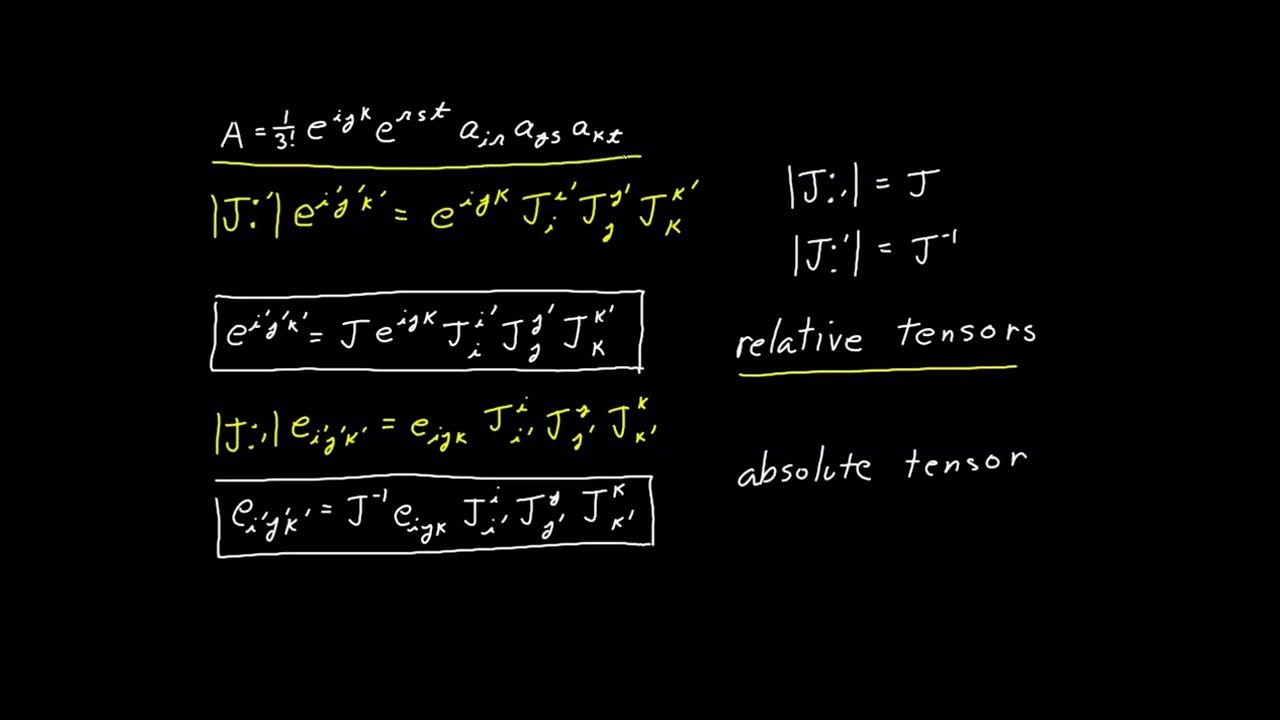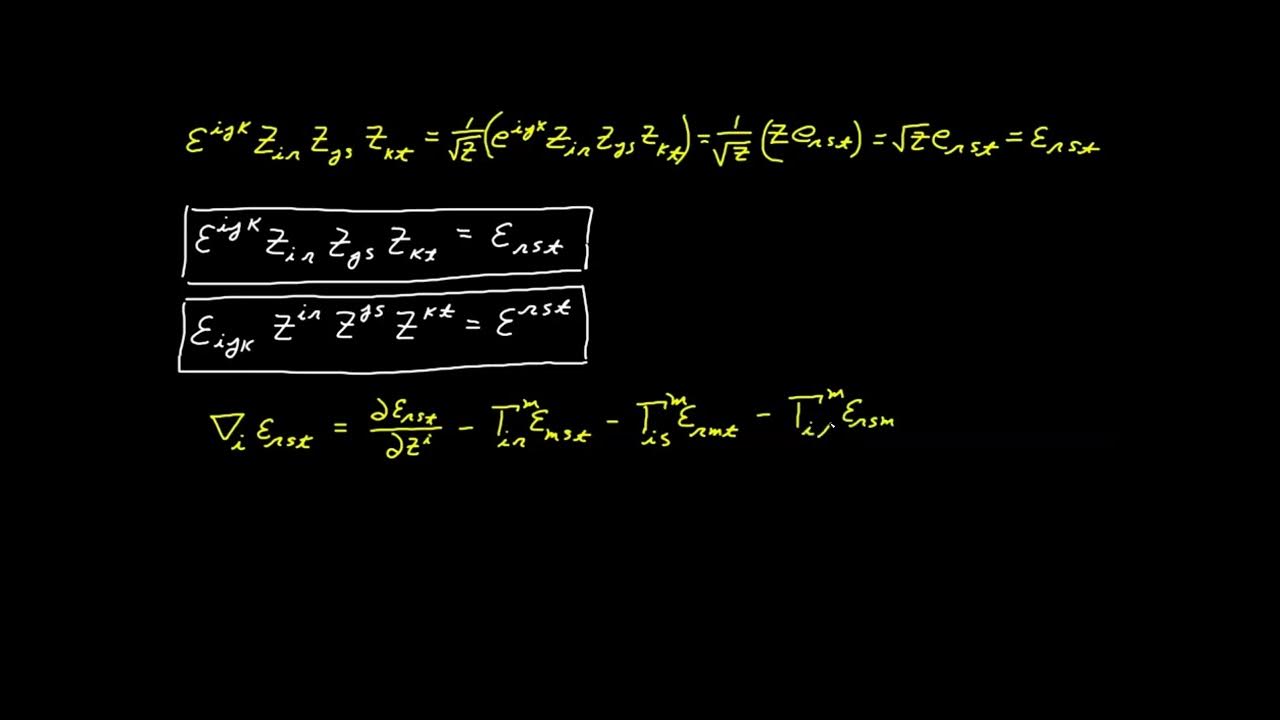Video 43 - Tensor Symmetry
TLDRIn this educational video, the concept of tensor symmetries is explored, leading to the introduction of the permutation symbol. The script explains how tensors can be symmetric or anti-symmetric when their indices are interchanged, affecting the tensor's value. Totally symmetric tensors have 10 degrees of freedom, while totally anti-symmetric tensors have just one, due to the constraints imposed by their properties. The video concludes with the definition of permutation symbols, which are skew-symmetric and simplify the representation of determinants, setting the stage for further exploration in the next episode.
Takeaways
- 📚 The video discusses tensor symmetries and introduces the permutation symbol in the context of tensor calculus.
- 🔄 A tensor is symmetric with respect to its first two indexes if swapping them results in the same value, and similarly for the second and third indexes.
- 🔄 If a tensor is symmetric with respect to the first two and last two indexes, it must also be symmetric with respect to the first and third indexes.
- 📉 A totally symmetric tensor with three indexes has only 10 unique elements out of 27 due to symmetry constraints, reducing its degrees of freedom to 10.
- ➡️ The script explains that a tensor is anti-symmetric (or skew-symmetric) if swapping two indexes results in the negative of the original value.
- 📉 For a tensor to be totally anti-symmetric, flipping any two indexes must change the sign of the value, leading to only one degree of freedom.
- 🔢 In a totally anti-symmetric system with three indexes, only the permutations of 1, 2, and 3 can be non-zero, with the rest being zero due to duplicate indexes.
- 🔄 The value of a totally anti-symmetric tensor is determined by whether the permutation of indexes is even or odd, resulting in positive or negative values respectively.
- 🆕 The video introduces permutation symbols, denoted as eijk, which are skew-symmetric with a primary value of 1, used to represent the sign of tensor permutations.
- 📝 The permutation symbols allow for a compact representation of tensors, especially useful for determinants, as they indicate the sign based on even or odd permutations.
- 🔑 The takeaways from the video script include the concepts of tensor symmetry, anti-symmetry, degrees of freedom, and the utility of permutation symbols in tensor calculus.
Q & A
What is the basic concept of tensor symmetry discussed in the video?
-Tensor symmetry refers to the property of a tensor where the value of the tensor remains unchanged when the order of any two indices is swapped. If this holds true for any pair of indices, the tensor is said to be totally symmetric.
What is the significance of the permutation symbol in tensor calculus?
-The permutation symbol is a new tensor calculus object introduced to represent the sign changes that occur when indices are permuted in a tensor. It is skew-symmetric and has a primary position value of 1, helping to simplify expressions involving permutations of tensor indices.
How many unique elements can a totally symmetric tensor with three indices have at most?
-A totally symmetric tensor with three indices can have a maximum of 10 unique elements due to the symmetry constraints, which reduce the number of independent components from 27 to 10.
What is the concept of anti-symmetry or skew-symmetry in the context of tensors?
-Anti-symmetry or skew-symmetry in tensors means that the sign of the tensor changes when any two indices are swapped. If this property holds for all pairs of indices, the tensor is said to be totally anti-symmetric or skew-symmetric.
How many degrees of freedom does a totally symmetric tensor with three indices have?
-A totally symmetric tensor with three indices has 10 degrees of freedom, which means there are 10 independent values that can vary while still adhering to the symmetry constraints.
What happens to the tensor values when duplicate indices occur in a totally anti-symmetric tensor?
-In a totally anti-symmetric tensor, if any of the indices are duplicates, the value of the tensor at that index combination must be zero due to the anti-symmetry constraints.
How many non-zero elements are there in a totally anti-symmetric system with three indices?
-In a totally anti-symmetric system with three indices, there are only six non-zero elements, corresponding to the six unique permutations of the numbers 1, 2, and 3 without any duplicates.
What is the degree of freedom in a totally anti-symmetric or skew-symmetric system with three indices?
-A totally anti-symmetric or skew-symmetric system with three indices has only one degree of freedom. Once the value of one permutation (e.g., s123) is established, all other elements are determined by the symmetry properties.
Why are there two different permutation symbols defined in the video?
-Two different permutation symbols are defined to handle different cases of index positions in tensors. One permutation symbol is used for when the indices are in the lower position, and the other is used for when the indices are in the upper position, ensuring that the indices match up correctly in expressions.
What is the primary value of the permutation symbols eijk and its significance?
-The primary value of the permutation symbols eijk is 1. This signifies that the permutation symbols are skew-symmetric and have a non-zero value only for unique index permutations, being 1 for even permutations and -1 for odd permutations.
Outlines
📚 Introduction to Tensor Symmetries and Permutation Symbols
This paragraph introduces the concept of tensor symmetries, focusing on the properties of a tensor with three dimensions and indices. It discusses how the tensor's value remains the same when the first two or last two indices are flipped, indicating symmetry. The idea that if a tensor is symmetric with respect to the first two and last two indices, it must also be symmetric with respect to the first and third is explored. The video also introduces the concept of total symmetry, where any permutation of indices results in the same value, and explains that this limits the number of unique elements in a tensor to 10, out of a possible 27, due to the constraints of symmetry.
🔄 Anti-Symmetry and the Skew-Symmetric Tensor
The second paragraph delves into the anti-symmetric properties of tensors, where flipping two indices results in the negation of the tensor's value. It explains that if a tensor is anti-symmetric with respect to two different pairs of indices, it must also be anti-symmetric with respect to the remaining pair. The concept of total anti-symmetry or skew-symmetry is introduced, where any permutation of indices that results in a change of sign indicates that the system is skew-symmetric. The restrictions on the degrees of freedom in a skew-symmetric system are discussed, noting that only tensors with unique indices can be non-zero and that the presence of duplicate indices results in a value of zero.
🔄🔄 Deep Dive into Anti-Symmetric Systems and Degrees of Freedom
Building on the previous discussion, this paragraph further explores anti-symmetric systems, specifically with three indices. It illustrates how the value of an anti-symmetric tensor is determined by the permutation of its indices, with only one degree of freedom. Establishing the value of one specific permutation sets the values for all other permutations due to the system's anti-symmetry. The explanation includes how flipping indices an even number of times results in a positive value, while an odd number of flips yields a negative value, highlighting the importance of even and odd permutations in skew-symmetric systems.
🆕 Introducing Permutation Symbols for Tensor Representation
This paragraph introduces permutation symbols as a new tool for representing the sign changes in tensor permutations. It defines two types of permutation symbols, both of which are skew-symmetric with a primary value of 1. The value of these symbols is zero for duplicate indices, 1 for even permutations, and -1 for odd permutations. The use of these symbols simplifies the representation of anti-symmetric tensors, such as the scalar value 's' multiplied by the permutation symbol. The paragraph concludes with a note on the utility of permutation symbols in representing determinants, which will be explored in subsequent videos.
📐 Conclusion: Tensor Symmetry, Anti-Symmetry, and Permutation Symbols
The final paragraph summarizes the key points discussed in the video. It revisits the concepts of tensor symmetry and anti-symmetry, emphasizing the impact on the number of unique tensor components and degrees of freedom. The paragraph reiterates that a totally symmetric tensor with three indices has 10 degrees of freedom, while a totally anti-symmetric tensor has only one. It also recaps the definition and significance of permutation symbols, setting the stage for further exploration of their applications in determinants in future videos.
Mindmap
Keywords
💡Tensor Calculus
💡Symmetry
💡Permutation Symbol
💡Index Permutation
💡Totally Symmetric
💡Degrees of Freedom
💡Anti-Symmetric
💡Duplicate Index
💡Scalar Value
💡Determinants
Highlights
Introduction to the concept of tensor symmetries and the permutation symbol in tensor calculus.
Exploration of the symmetry properties of a tensor with three free indices, each ranging from one to three.
Explanation of tensor symmetry with respect to the first two indices, leading to equal values when indices are flipped.
Discussion on the implications of a tensor being symmetric with respect to the second and third indices.
Derivation that if a tensor is symmetric in two pairs of indices, it must also be symmetric in the first and third.
Introduction of the concept of total symmetry, where any permutation of indices results in the same value.
Revelation that a totally symmetric system with three indices has a maximum of 10 unique elements.
Introduction to anti-symmetry, where flipping indices results in the negative value of the tensor.
Condition for a tensor to be totally anti-symmetric or skew-symmetric, affecting all pairs of indices.
Observation that a totally anti-symmetric tensor with three indices has only one degree of freedom.
Explanation of the restriction that duplicate indices in an anti-symmetric tensor result in a value of zero.
Identification of non-zero elements in an anti-symmetric system as permutations of the numbers 1, 2, and 3.
Introduction of permutation symbols eijk and their properties, including skew-symmetry and primary position value.
Use of permutation symbols to simplify the representation of anti-symmetric tensors.
Differentiation between odd and even permutations and their impact on the sign of the permutation symbol.
Conclusion summarizing the importance of tensor symmetries, degrees of freedom, and the introduction of permutation symbols.
Transcripts
5.0 / 5 (0 votes)
Thanks for rating:





